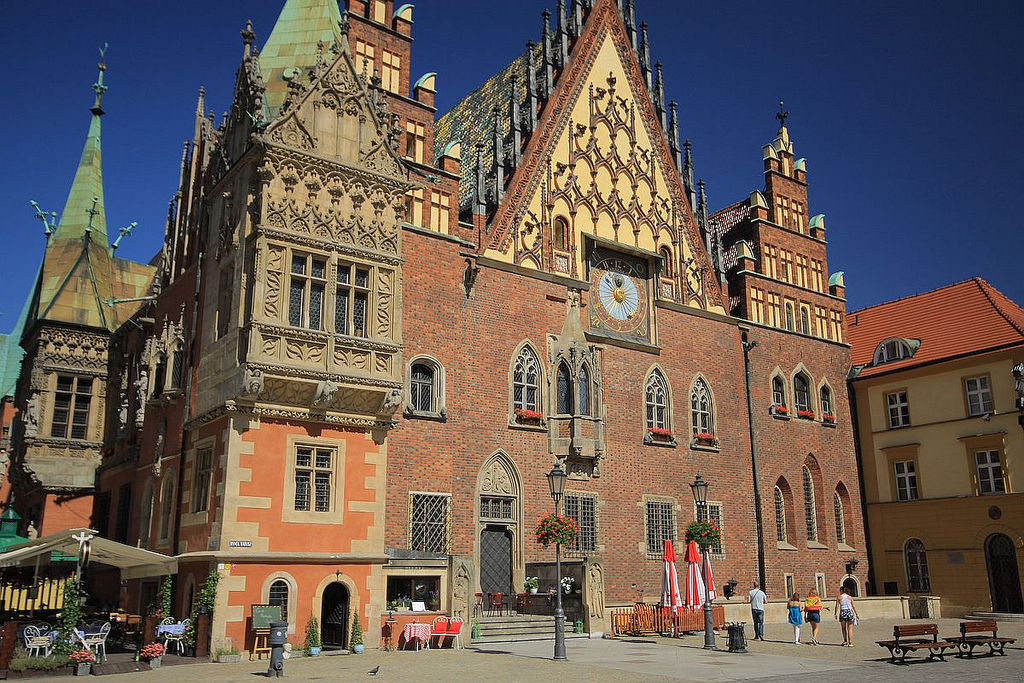
a wooden church which can accommodate 7500 worshippers!

by the biggest Cistercian monastery in the world

in a castle which once belonged to Prussian royal family

how the famous Bolesławiec (Bunzlau) pottery is made


In the morning, we will drive to the Lower Silesia’s capital–Wrocław (in German Breslau)–the European Capital of Culture 2016. After a lunch based on local specialties, we will start sightseeing the Flower of Europe, as once Wrocław was called. We will walk down the Old City’s street, visit Gothic churches of Saint Elizabeth of Hungary, Saint Adalbert of Prague and an impressive city hall. Then we’ll go to Four Temples Quarter, where we’ll find Orthodox, Protestant and Catholic churches, as well as a synagogue.
Overnight stay in Wrocław.
We will start our day by visiting Wrocław University, formerly a Jesuit Academy, with its beautiful baroque rooms – Oratorium Marianum, Leopoldine Hall and the richly ornamented church of the Most Holy Name of Jesus. Then we will walk to Ostrów Tumski, one of many islands situated at the meandering Odra river. Ostrów is the oldest part of Wrocław famous for its Romanesque church of Saint Giles and the impressive Gothic cathedral of Saint John. After lunch, we will cruise the Odra river, reaching the most famous Modern architecture sight of Wrocław–Centennial Hall built in 1913. Together with the nearby Pavilion of Four Cupolas and Japanese Garden it has been inscribed on the UNESCO World Heritage List. Then we will have a chance to listen to a concert in the National Forum of Music known for its great acoustics–a nice sum-up of an all-day long sightseeing.
Overnight stay in Wrocław.


In the morning, we will leave Wrocław heading to Świdnica (Schweidnitz), formerly a capital of Duchy of Świdnica-Jawor. On the way, we will stop in Sobótka-Górka (Gorkau), where near a former Augustine cloister a craft brewery has been recently re-established. A local brewer will guide as through the beer production process, at the end of which we will have a chance to try a drink once so famous in the entire Lower Silesia. Upon arriving at Świdnica and having a lunch, we will sightsee the city with its pearl–the UNESCO-listed wooden Peace Church. It was built under the conditions of the Peace of Westphalia from 1648, which brought to an end the Thirty Years’ War. No nails were used in its construction, however, it’s big enough to accommodate 7500 worshippers!
Overnight stay in Świdnica.
After breakfast, we will leave for Książ (Fürstenstein), one of three biggest castles in Poland. It was built by the Piast family (a royal Polish dynasty) in 12th century but from 1509 until 1941 was owned by the Hochberg family, inheritors of one of the largest fortunes in Prussia. After a lunch break in the 18th-century-old inn, we will head off for Cistercian monastery in Krzeszów (Grüssau). We will visit, among other things, beautiful late Baroque Sanctuary of the Gracious Mother of God and Saint Joseph church decorated by Michael Willmann nicknamed the “Silesian Rembrandt”. From Krzeszów we will drive to our hotel situated in one of the renovated palaces of the Jelenia Góra Valley (Hirschberger Tal).
Overnight stay near Jelenia Góra.

We will start the day by sightseeing the palace and its gardens, then we will drive to Miedzianka (Kupferberg) located near-by. Once it was known as one of the most beautiful towns of Silesia but because of wasteful exploitation of copper mines it was suddenly abandoned. After visiting Miedzianka, we will go further up the Jelenia Góra Valley, a picturesque region which in 19th century became a popular holiday destination among Prussian aristocrats. At just 102 square kilometres some 30 residencies were built–which is more than in Loire Valley! We will visit, among others, an impressive park in Bukowiec (Buchwald) and Wojanów Castle (Schloss Schildau). Of course, there will be also time for some tasting–besides the traditional Silesian lunch, we’re going to try local goat cheese and herb liqueur prepared in one of the palaces. We will sum up the day by visiting Bad Warmbrunn–also known as Cieplice Śląskie. This spa centre famous for its hot springs was once known across the whole Europe, and continues to amaze next generations with its splendid park, theatre and numerous villas belonging to the resort’s clients.
Overnight stay near Jelenia Góra.
In the morning, we will leave for Bolesławiec (Bunzlau), Polish capital of ceramics. Its pottery has been manufactured since Medieval ages from locally excavated, natural clay and then decorated with characteristic, multi-colour dots. After visiting a workshop, we will drive to Lubiąż (Leubus), to the Cistercian monastery established as early as in 12th century. Although it is not used by monks anymore, this astonishing baroque complex is still the biggest Cistercian cloister in the world! After a light lunch, we will head off to a local winery located in a region which tradition of winemaking dates to the 13th century. A nice tasting of meads and wines will make a good introduction to the finale of that day–a farewell dinner in Wrocław.
Overnight stay in Wrocław.
After breakfast, we will leave for Trzebnica (Trebnitz), a town located about 30 kilometres from Wrocław and famous for Saint Hedwig cult, the patron saint of the region and of Poland. The duchess of Silesia and of Greater Poland lived in 13th century, and founded numerous hospitals and monasteries. Trzebnica’s sanctuary, in which St. Hedwig is buried, is a beautiful combination of Romanesque and baroque architecture, and is regarded as one of the most exquisite in the province. After a visit in the church and a lunch, we will slowly start our return to Warsaw.
